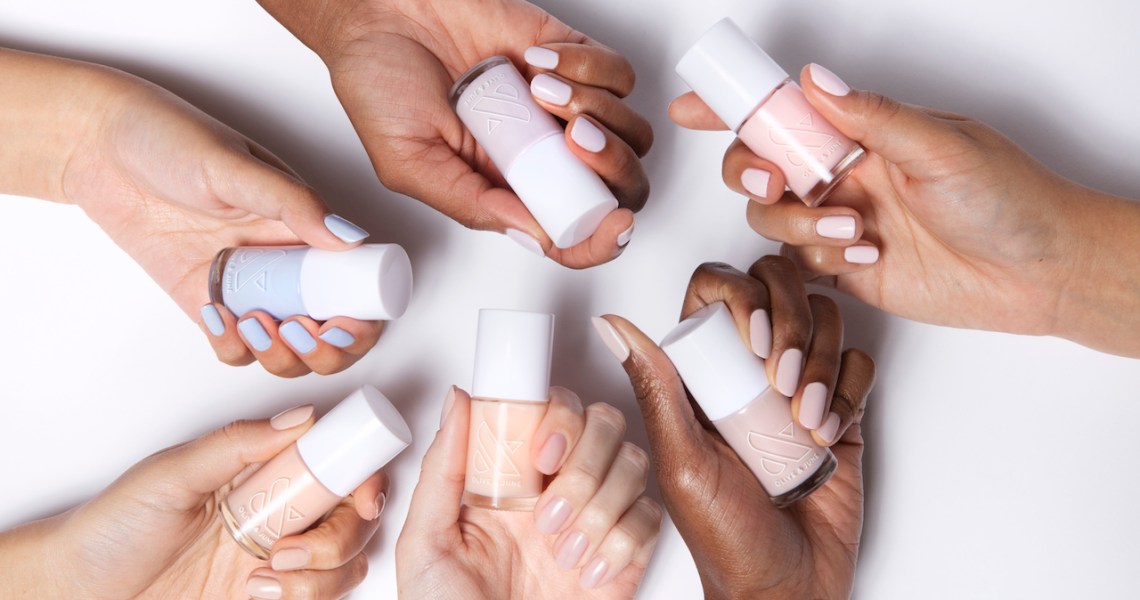The nail-care market continues to trend upward.
California-based nail salon brand Olive & June, known for its three salons in Beverly Hills, Santa Monica and Pasadena, wants to elevate the at-home manicure. On March 14, it launched its first foray into polishes, including six non-toxic shades and a top coat. It also debuted a rubberized tool dubbed “The Poppy,” which attaches to nail polish bottles to facilitate easier application. The polishes, which retail for $8, are “7-free,” meaning they are free of chemicals including dibutyl phthalate (DBP), ethyl tosylamide, toluene, formaldehyde, formaldehyde resin, camphor and xylene.
“The in-bound response from our community was not just, ‘When are you launching products?’ but also, ‘What do I do with my cuticles?’ and ‘How do I remove my gels?’ Clients really felt lost when they weren’t in our salons and were so unsure about how to create a nail routine at home,” said Sarah Gibson Tuttle, Olive & June founder and CEO.
Thanks to the new offerings, Gibson Tuttle expects that Olive & June product sales will grow 10 times in 2019. The brand’s only other products are a line of nail stickers, which it launched in April 2018 and are sold exclusively on OliveJune.com and in its three salons. Gibson Tuttle declined to share year-to-date sales on the stickers, but did say the company sold over 1,000 sets on launch day last April.
Olive & June is in-step with larger category trends. The global nail product market is expected to grow by over 7 percent in the next five years to nearly $6.5 billion, according to market research firm Euromonitor International. However, it is dominated by conglomerates like Coty and L’Oréal, which rank No. 1 and No. 2, respectively. In the U.S., Coty’s penetration comes from OPI and Sally Hansen, while L’Oréal’s is through Essie and Maybelline. Of these brands, only OPI and Essie dabble in the non-toxic space. They are considered “3-free,” meaning they do not use DBP, toluene and formaldehyde chemicals.
However, the at-home market presents larger potential: According to a 2017 IBISWorld industry report, customers only spend $1.2 billion on DIY products, but spend $9 billion in salons.
Nail brand Tenoverten, which boasts an “8-free” collection, also recently saw the opportunity of the at-home market, when it debuted its first large-scale wholesale partnership with Target in February. By launching its 24 polish shades and five nail-care products in 800 Target doors across 49 states, Tenoverten co-founder Nadine Abramcyk expects to shift its business from being 90 percent through Tenoverten’s salon services in six nail salon locations in 2018 to just 50 percent in 2019. The remaining 50 percent will be through sales of products, sold both through retail partners like Target and direct to consumer.
Ad position: web_incontent_pos1
For Olive & June, its non-toxic shades were based on the most requested customer shades in its three salons (and are named after O&J friends like actress Mandy Moore and Instagram head of fashion partnerships Eva Chen). The “The Poppy” bottle hand, which has a patent, was made in collaboration with Olive & June’s 60-person in-house team, made up largely of manicurists. The goal is to assist everyday clients with painting their nails with both their dominant and non-dominant hands. In an internal study, Olive & June did with its target customer group (18- to 25-year-old women) only 16 percent said they do their own nails weekly or bi-weekly, and only 20 percent said they can only afford to go to the nail salon more than three times a year.
“Manicures should not just have to exist in salons alone, and we think teaching more people how to do their nails will give our clients more options, so they’re not relying solely on a manicurist for advice,” said Gibson Tuttle.
L’Oréal’s Modiface also recently tried to get a handle on customer education via its Virtual Nail Salon, which launched in November and virtually applies nail polish shades and textures on live videos of nails. The company does not associate the app with any specific nail polish brand.
Though the employment of manicurists and pedicurists in salons is projected to grow by 13 percent by 2026, according to Bureau of Labor Statistics, Gibson Tuttle sees Olive & June’s opportunity as in-line with larger consumer at-home shifts, like Netflix or self-care.
That Olive & June’s products will be available for purchase only on OliveJune.com was strategic in that sense. Gibson Tuttle is creating a new content arm on the brand’s site. To coincide with the new launches, the brand will be launching in March an “encyclopedia” of the 30 most-asked nail questions and corresponding answers, which will be vetted by Gibson Tuttle and the brand’s in-house manicurists. In addition, Olive & June’s existing Tumblr-like blog of how-to videos will be replaced with regular weekly articles and videos of Gibson Tuttle and her team answering evergreen questions. The focus will not be on trends or celebrities, she said.
Ad position: web_incontent_pos2
As with the new products themselves, Olive & June will be marketing the content via its Instagram channel, where it has over 196,000 followers, and through email newsletters.
“An affordable option that women can feel good about is something that doesn’t exist in the at-home nail category at all today,” said Gibson Tuttle. “We are in the crowded side of the market with the salons, and though we make thousands of women in our salons happy each week, we think there are many more waiting for us to come to them.”




